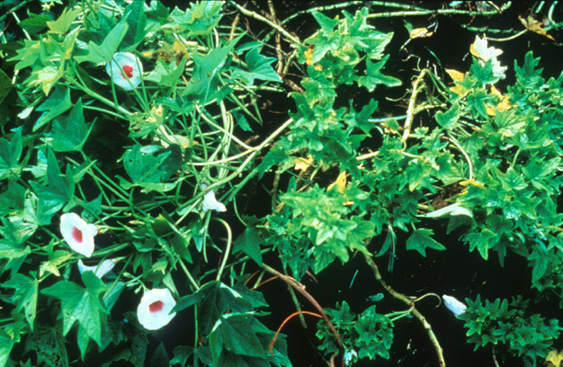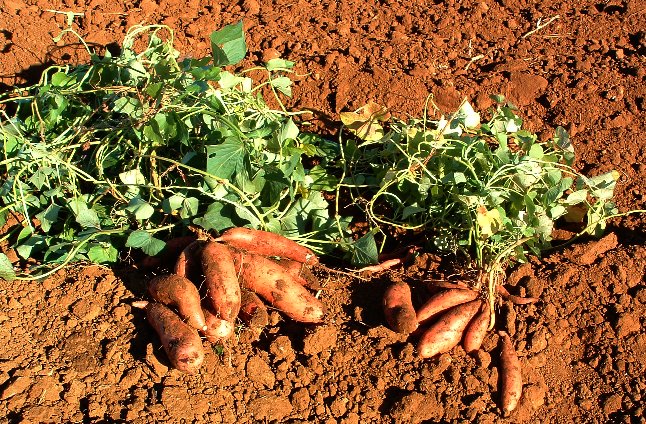|
|
Class |
Mollicutes |
|
Order |
Acholeplasmatales |
Crop losses are unknown. However, the disease causes
greatest losses in dry areas, which favour high leafhopper populations. Some
infected plants do not survive until harvest or they produce few harvestable
roots.
Widespread in Asia, Australia and the
western Pacific. The distribution pattern correlates closely with that of its
principal leafhopper vectors .
In Asia, witches' broom has been reported in Bangladesh,
China (Fujian, Taiwan), India, Indonesia, Japan (Ryukyu Archipelago), Korea,
Republic of Korea, Malaysia, and Philippines. In
Oceania, it is found in Australia (Northern Territory), Belau,
Federated states of Micronesia, New Caledonia, New Zealand, Niue, Papua New
Guinea, Solomon Islands, Tonga, and Vanuatu.
The initial symptoms consist of a transient vein
clearing followed by the development of new leaves that are distinctly
smaller and more chlorotic (paler) than normal. Generally only scattered
individual plants are infected, and they are conspicuously smaller than adjacent
uninfected plants. Leaves may have a more rounded shape, often
curling at the leaf margins. The growth
habit tends to be more erect than in healthy plants, internodes are shortened
and there is a proliferation of axillary
shoots which, together with a greatly reduced root system, result in weak plants
with a compressed or bushy appearance. The number and quality of storage roots
are reduced, with few or no harvestable storage roots being produced on severely
affected plants. Production of latex in vines and roots is also reduced.
Characteristic pleomorphic bodies ranging from 0.1 to 1.0
Ám in diameter, with a well defined unit membrane.
The SPLL phytoplasma
can be transmitted by the leafhopper Orosius lotophagorum ryukyuensis and
Nesophrosyne ryukyuensis in a persistent manner. Low annual rainfall and
prolonged dry seasons favour the vector
and, under these conditions, the disease can reach epidemic proportions.
Infected planting material is also important in the dissemination of the
disease. As the disease has an exceptionally long incubation period in
sweetpotato (up to 283 days) following graft transmission, infected planting
material can appear healthy.
In small, local cultivations, vines may be taken from
more vigorous plants in order to establish a subsequent crop. While this
practice may assist in selecting plants that are better able to tolerate
infection by the phytoplasma, it probably contributes to the promulgation of the
disease in the crop; this situation may be further exacerbated where crop
plantings overlap or where the previous crop is not removed.
Primary natural host is sweetpotato (Ipomoea batatas).
Wild hosts (Ipomoea nil, Pharbitis purpurea, Ipomoea pes-caprae) act as
reservoirs.
Alternative experimental hosts of SPLL phytoplasma are Ipomoea
setosa, I. triloba, I. indica, I. ericolor, Pharbitis purpurea, P.
nil, and Catharanthus roseus.
Cultural control
Sanitation (removal of all previous crop debris from the field and use of healthy planting material) has
provided the best control to date. The removal and destruction of diseased
plants and wild hosts reduces the spread of the disease.
Chemical control
Insecticides could prove useful in the production of
nursery stock or in commercial plantings, but not when sweetpotato is grown as a
subsistence crop.
Tetracycline causes remission of symptoms leading to the
production of disease-free young shoots, and may be of use in breeding and
selection programmes; however, it is unlikely to be commercially significant.
Host-plant resistance
There is little evidence of resistance to the disease.
Only one clone from Solomon Islands and another from Taiwan showed moderate
resistance, but these clones are affected by SPLL isolates from different
geographical regions.
Movement of germplasm
Phytoplasma-free vegetative material should be
transferred as in-vitro plantlets.
Chen, M.J. 1972. Electron microscopic studies of plant
pathogenic mycoplasma found in Taiwan. Proceedings of the National Science
Council (Republic of China), 5:61-77.
Dabek, A.J., Sagar, C. 1978. Witches' broom chlorotic
little leaf of sweet potato in Guadal-canal, Solomon Islands, possibly caused by
mycoplasma-like organisms. Phytopathologische. Zeitschrift, 92: 1-11.
Gibb, K.S., Padovan, A.C., Mogen, B.D. 1995. Studies on
sweet potato little-leaf phytoplasma detected in sweet potato and other plant
species growing in Northern Australia. Phytopathology, 85(2):169-174.
Green, S.K., Luo, C.Y., Lee, D.R. 1989. Elimination of
mycoplasma-like organisms from witches' broom infected sweet potato. Journal of
Phytopathology, 126(3):204-212.
Jackson, G.V.H., Zettler, F.W. 1983. Sweet potato
witches' broom and legume little-leaf diseases in the Solomon Islands. Plant
Disease, 67(9):1141-1144.
Kahn, R.P., Lawson, R.H., Monroe, R.L., Hearon, S. 1972.
Sweet potato little leaf (witches'-broom) associated with a mycoplasma-like
organism. Phytopathology, 62:903-909.
Ko, H.C., Lin, C.P. 1993. Development and application of
cloned DNA probes for a mycoplasmalike organism associated with sweetpotato
witches'-broom. Phytopathology, 84:468-473.
Shen, W.C., Lin, C.P. 1993. Production of monoclonal
antibodies against a mycoplasmalike organism associated with sweetpotato
witches' broom. Phytopathology, 83: 671-675.
Summers, E.M. 1951. "Ishuku-byo" dwarf of sweet
potatoes in the Ryukyu Islands. Plant Disease Reporter, 35:255-267.
Zhang, B-C., Huang, Y-C. 1990. A list of important plant
diseases in China. Review of Plant Pathology 69(3), 97-118.
Contributed
by: Segundo
Fuentes
and Luis Salazar
|
Taxonomy
Economic
importance
Geographical
distribution
Symptoms
Morphology
Biology
and ecology
Host
range
Management
References

Shortened
internodes and compressed growth habit are typical symptoms of witches'
broom (S. Fuentes & L. Salazar).

Proliferation
of shoots and reduced leaf size in infected plant. (F. Zettler, APS).

General or mottled chlorosis and yellowing of oldest leaves often
accompanies the reduction in leaf size (E. Coleman).

Reduced size of whole plant and of storage roots, in a plant infected
with SPLL (right) compared with the adjacent uninfected plant (E.
Coleman). |

